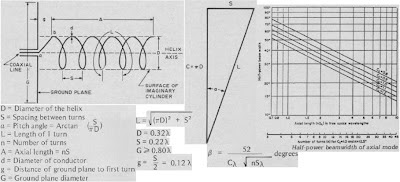Helical Antenna Calculator For Amateur Radio
This program inputs helix length, diameter and the 1/4-wave resonant frequency. It then calculates the number of turns on the helix for resonance.
Also input is the ratio of wire diameter to winding pitch. Various other characteristics of interest are calculated including wire gauge and efficiency.
Within the range of validity, the set of output data always corresponds to the condition of a 1/4-wave resonant antenna. Data is valid provided helix dimensions and wire gauge allow close-wound practical antenna construction. Accuracy is satisfactory provided helix length/diameter ratio is in the range 5 to 100.
Most designs will be in the Velocity Factor range of .01 to 0.2, where VF is a measure of miniaturization. The program’s arithmetic applies from MF to VHF.
Close-wound or fairly close coil turns are required. Don’t use wire thinner than needed to fill the helical length. Enamel or PTFE insulated copper wire is appropriate.
If spaced bare wire is used because of high power, make the ratio (wire-diameter)/(winding pitch) = 0.71. But winding many spaced turns is a tedious job. With high power, ionization will eventually occur at the extreme top. Most of the transmitter power will be dissipated in the helical winding anyway due to poor efficiency. The antenna is a high-frequency Tesla coil. The resonant frequency of a helical antenna is sensitive to the difficult to control diameter. Q is high. So it may be necessary to prune helix height after deliberately making it too long. Helical antennas are single-frequency, narrow-bandwidth devices.
For example, to shift the resonant frequency of a 160m band antenna, with a 3dB bandwidth of 7 kHz, by 3 kHz, requires the removal of only 2 turns from a total of 1160 turns. It is probably more convenient to remove a small number of turns and add a very short straight rod or wire which can be more easily pruned. The extra rod or wire need not be vertical. It can extend sideways. The primary reason for using a helical antenna is to obtain a low overall height.
While learning to use the program get familiar with 14 AWG enameled wire by adjusting for 580 turns-per-metre and Ratio = 0.95 Or 460 TPM for 12 AWG.
Accuracy may fall off when helix length is less than about 5 times its diameter. When length is greater than 100 times diameter the antenna can become non-self-supporting and is probably too high anyway. It can be guyed.
Radiating efficiency increases rapidly with height but when low height is an objective radiating efficiency must be sacrificed.
The number of turns on the 50-ohm link coupling coil is approximate. It should be of insulated wire and wound over the bottom end of the helix. Use an antenna analyzer. For 75-ohms increase the number of link turns by about 22 percent.
Remember, helix diameter is equal to the diameter of the former on which the wire is wound plus wire diameter. It is usual to choose former diameter first. Don’t forget to add wire diameter to former diameter to obtain actual diameter.
Basic Operating Procedure
Enter frequency, helix diameter, helix height, ratio, ground loss. Then vary helix diameter until a suitable wire gauge is found. Vary diameter to fit to size of nearest standard former. Then trim height for exact wire gauge.
The formula for the relationships between helix length, diameter, resonant frequency and turns-per-metre has been adapted and improved from an article in “Reference Data For Radio Engineers” of unknown author and issue date.
I copied some data into my notebooks about twenty-five years ago. How the arithmetic was derived I have never understood. The derivation was not properly explained.
Recently I have compared results with my own programs and found them to be in the same ball park. My own programs, which have an altogether different mathematical starting point, have been checked at HF on the 160 and 80 metre bands by practical helical antenna construction.
The advantage of using the “Reference Data” is that an explicit expression for the number of turns on the helix can be derived from it:
Number of Turns = Function( Helix Length, Helix Diameter, Frequency )
It is too complicated to reproduce here.
If it is correct at one frequency then it is also likely to be correct over a wide range of frequencies such as MF to VHF. It also means similar explicit expressions can be derived for each of the other three variables. Which makes it easy to incorporate the arithmetic in a practical computer program.
Run this Program from the Web or Download and Run it from Your Computer
This program is self-contained and ready to use. It does not require installation. Click this link Helix_2 then click Open to run from the web or Save to save the program to your hard drive. If you save it to your hard drive, double-click the file name from Windows Explorer (Right-click Start then left-click Explore to start Windows Explorer) and it will run.
from http://www.qsl.net/va3iul/Antenna/Wire%20Antennas%20for%20Ham%20Radio/111-Helix_Antenna.jpg







Post Comment